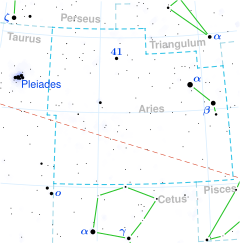Binary star system in the constellation Aries
Epsilon Arietis (ε Ari, ε Arietis) is the Bayer designation for a visual binary [ 8] star system in the northern constellation of Aries . It has a combined apparent visual magnitude of 4.63[ 2] parallax shift of 9.81 mas ,[ 1] light-years (100 parsecs ), give or take a 30 light-year margin of error . It is located behind the dark cloud MBM12.[ 6]
The brighter member of this pair has an apparent magnitude of 5.2.[ 3] angular separation of 1.426 ± 0.010 arcseconds from the brighter component, along a position angle of 209.2° ± 0.3° ,[ 8] [ 3] A-type main sequence stars with a stellar classification of A2 Vs.[ 4] absorption lines in the spectrum are distinctly narrow.) In the 2009 Catalogue of Ap, HgMn and Am stars , the two stars have a classification of A3 Ti,[ 3] Ap stars with an anomalous abundance of titanium. Within the measurement margin of error, their projected rotational velocities are deemed identical at 60 km/s.[ 4]
Name
This star system, along with δ Ari , ζ Ari , π Ari , and ρ3 Ari , were Al Bīrūnī's Al Buṭain (ألبطين ), the dual of Al Baṭn , the Belly.[ 9] Technical Memorandum 33-507 - A Reduced Star Catalog Containing 537 Named Stars , Al Buṭain were the title for five stars :δ Ari as Botein , π Ari as Al Buṭain I , ρ3 Ari as Al Buṭain II , ε Ari as Al Buṭain III and ζ Ari as Al Buṭain IV [ 10]
In Chinese astronomy, Epsilon Arietis may be or may be part of Tso Kang (from Cantonese 左更 zogang , Mandarin pronunciation zuǒgēng ).[ 11] [ 12]
References
^ a b c d e f van Leeuwen, F. (November 2007), "Validation of the new Hipparcos reduction", Astronomy and Astrophysics , 474 (2): 653– 664, arXiv :0708.1752 Bibcode :2007A&A...474..653V , doi :10.1051/0004-6361:20078357 , S2CID 18759600 . ^ a b c d Eggen, Olin J. (November 1963), "Luminosities, colors, and motions of the brightest A-type stars", Astronomical Journal , 68 : 697, Bibcode :1963AJ.....68..697E , doi :10.1086/109198 . ^ a b c d Renson, P.; Manfroid, J. (May 2009), "Catalogue of Ap, HgMn and Am stars", Astronomy and Astrophysics , 498 (3): 961– 966, Bibcode :2009A&A...498..961R , doi :10.1051/0004-6361/200810788 ^ a b c d e Royer, F.; et al. (October 2002), "Rotational velocities of A-type stars in the northern hemisphere. II. Measurement of v sin i", Astronomy and Astrophysics , 393 : 897– 911, arXiv :astro-ph/0205255 Bibcode :2002A&A...393..897R , doi :10.1051/0004-6361:20020943 , S2CID 14070763 . ^ Gontcharov, G. A. (November 2006), "Pulkovo Compilation of Radial Velocities for 35 495 Hipparcos stars in a common system", Astronomy Letters , 32 (11): 759– 771, arXiv :1606.08053 Bibcode :2006AstL...32..759G , doi :10.1134/S1063773706110065 , S2CID 119231169 . ^ a b c d Rica, Francisco (April 2012), "Orbital Elements for BU 741 AB, STF 333 AB, BU 920 and R 207", Journal of Double Star Observations , 8 (2): 127– 139, Bibcode :2012JDSO....8..127R . ^ "eps Ari" . SIMBAD Centre de données astronomiques de Strasbourg . Retrieved 2012-08-05 .^ a b Scardia, M.; Prieur, J.-L.; Pansecchi, L.; Argyle, R. W.; Basso, S.; Sala, M.; Ghigo, M.; Koechlin, L.; Aristidi, E. (January 2007), "Speckle observations with PISCO in Merate - III. Astrometric measurements of visual binaries in 2005 and scale calibration with a grating mask" (PDF) , Monthly Notices of the Royal Astronomical Society 374 (3): 965– 978, Bibcode :2007MNRAS.374..965S , doi :10.1111/j.1365-2966.2006.11206.x ^ Allen, R. H. (1963). Star Names: Their Lore and Meaning 83 . ISBN 0-486-21079-0 . Retrieved 2010-12-12 .^ Jack W. Rhoads - Technical Memorandum 33-507-A Reduced Star Catalog Containing 537 Named Stars , Jet Propulsion Laboratory, California Institute of Technology; November 15, 1971 ^ Chevalier, S. , and Tsuchihashi, P. , (1911): "Catalogue d'Étoiles fixes, observés a Pekin sous l'Empereur Kien Long (Qianlong (Chien-Lung)), XVIIIe siecle", Annales de l'Observatoire Astronomique de Zô-Sé .^ 伊世同 『中西対照恒星図表』科学出版社 (in Chinese)
External links
